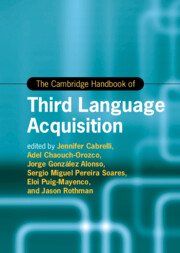Book contents
- The Cambridge Handbook of Third Language Acquisition
- Cambridge Handbooks in Language and Linguistics
- The Cambridge Handbook of Third Language Acquisition
- Copyright page
- Contents
- Figures
- Tables
- Contributors
- Introduction Multilingualism
- Part I Theoretical Approaches to L3/Ln
- Part II L3/Ln across Linguistic Domains
- Part III Becoming and Staying Multilingual at Different Ages
- Part IV L3/Ln in Action
- Part V L3/Ln and Cognition
- 20 Multilingualism and Cognitive Control in the Brain
- 21 Multilingualism and Cognitive Reserve
- 22 The Effects of Multilingualism on Brain Structure, Language Control and Language Processing
- 23 Mechanisms of Cognitive Aging in Multilingualism
- 24 Multilingualism and Language Impairment
- Part VI Research Methods in L3/Ln
- Index
- References
21 - Multilingualism and Cognitive Reserve
from Part V - L3/Ln and Cognition
Published online by Cambridge University Press: 13 July 2023
- The Cambridge Handbook of Third Language Acquisition
- Cambridge Handbooks in Language and Linguistics
- The Cambridge Handbook of Third Language Acquisition
- Copyright page
- Contents
- Figures
- Tables
- Contributors
- Introduction Multilingualism
- Part I Theoretical Approaches to L3/Ln
- Part II L3/Ln across Linguistic Domains
- Part III Becoming and Staying Multilingual at Different Ages
- Part IV L3/Ln in Action
- Part V L3/Ln and Cognition
- 20 Multilingualism and Cognitive Control in the Brain
- 21 Multilingualism and Cognitive Reserve
- 22 The Effects of Multilingualism on Brain Structure, Language Control and Language Processing
- 23 Mechanisms of Cognitive Aging in Multilingualism
- 24 Multilingualism and Language Impairment
- Part VI Research Methods in L3/Ln
- Index
- References
Summary
During the last decades, different concepts of reserve have been postulated to account for the brain’s capacity for resilience in the face of neurodegeneration. Lifelong bilingualism may be a reserve factor, delaying the onset of dementia by approximately four years. Nonetheless, the evidence remains inconsistent and the trajectory of the effects is not clear. For instance, it is unclear whether multilinguals have more cognitive benefits than bilinguals. This review aims to critically examine this question to delineate the major trends in the field. We first describe the overlap in the operationalization of reserve/resilience in order to provide a clear definition in support for such an approach in the field. We then review the bi-/multilingual literature to evaluate the current evidence for the question of whether bi-/multilingualism leads to increased reserve. Such considerations may lead to a re-evaluation of the construct in the bilingual literature and its implication in clinical studies.
- Type
- Chapter
- Information
- The Cambridge Handbook of Third Language Acquisition , pp. 555 - 576Publisher: Cambridge University PressPrint publication year: 2023

